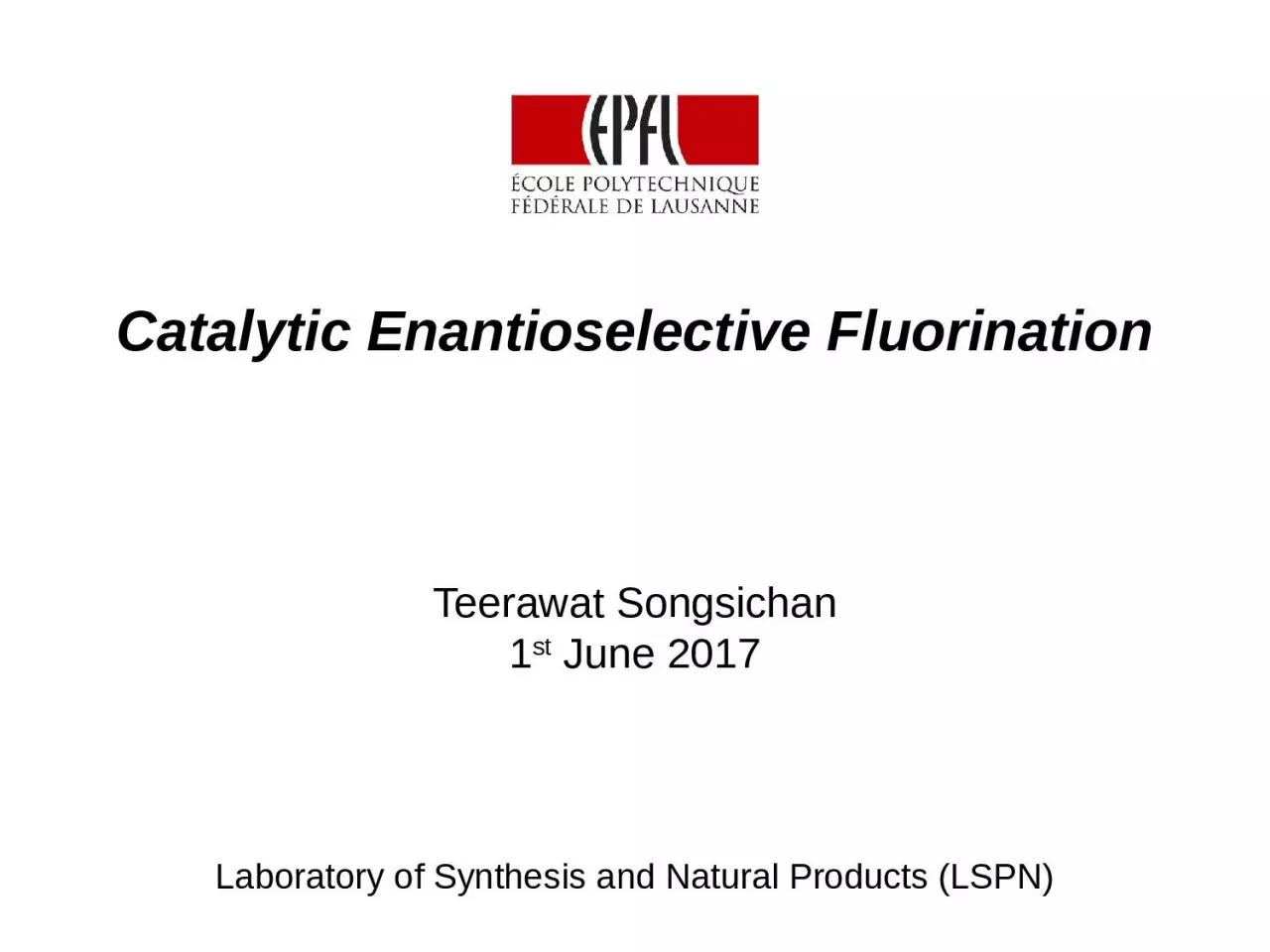

Teerawat Songsichan 1 st June 2017 Laboratory of Synthesis and Natural Products LSPN Content 1 Introduction 2 Electrophilic Fluorination 21 MetalCatalyzed Fluorination Involving Enolates ID: 1041921
Download Presentation The PPT/PDF document "Catalytic Enantioselective Fluorination" is the property of its rightful owner. Permission is granted to download and print the materials on this web site for personal, non-commercial use only, and to display it on your personal computer provided you do not modify the materials and that you retain all copyright notices contained in the materials. By downloading content from our website, you accept the terms of this agreement.
1. Catalytic Enantioselective FluorinationTeerawat Songsichan1st June 2017Laboratory of Synthesis and Natural Products (LSPN)
2. Content1. Introduction2. Electrophilic Fluorination 2.1 Metal-Catalyzed Fluorination Involving Enolates 2.2 Metal-Catalyzed Fluorination Not Involving Enolates 2.3 Organocatalytic Electrophilic Fluorination 2.4 Fluorination Using Multiple Catalysts 2.5 One-Pot and Tandem Processes3. Nucleophilic Fluorination4. Summary and Outlook- Catalytic Enantioselective Trifluoromethylation and Perfluoroalkylation- Catalytic Enantioselective Monofluoromethylation- Catalytic Enantioselective Difluoromethylation- Catalytic Enantioselective Trifluoromethylthiolation2
3. IntroductionImpact of Fluorine in PharmaceuticalsIt is well known that fluorine’s electronegativity, size, omniphobicity/lipophilicity, and electrostatic interactions can dramatically influence chemical reactivity.One of the major effects of fluorination is a modulation of acidity and basicity of a parent compound. This can strongly influence binding affinity, pharmacokinetic properties, and bioavailability of a given drug candidate.In general, about one-third of the top-performing drugs, currently on the market, contain fluorine atoms in their structures.Atorvastatin (Lipitor)treatment of high cholesterolFluticasone propionateanti-inflammatory drugCiprofloxacin (Ciprobay)antibacterial drugFustero, S.; Soloshonok, V. A.; Liu, H. Chem. Rev. 2013, 114, 2432.3
4. IntroductionCommon Fluorinating reagentsElectrophilic reagents - Elemental fluorine (F2) - Fluoroxyltrifluoromethane (CF3OF)- N-Fluoropyridinium salts- Selectfluor- N-Fluorobenzenesulfonimide (NFSI)Nucleophilic reagents - Ammonium fluoride (e.g. tetrabutylammonium fluoride, TBAF) - Pyridinium poly(hydrogen fluoride), PPHF (Olah’s reagent) - DAST [Et2NSF3] / Deoxofluor [(MeOCH2CH2)2NSF3]4
5. Electrophilic FluorinationMetal-Catalyzed Fluorination Involving EnolatesTi/TADDOL CatalystsTogni, A. Angew. Chem., Int. Ed. 2000, 39, 4359.5
6. Electrophilic FluorinationMetal-Catalyzed Fluorination Involving EnolatesTi/TADDOL CatalystsTogni, A. Beilstein J. Org. Chem. 2011, 7, 1421.6
7. Electrophilic FluorinationMetal-Catalyzed Fluorination Involving EnolatesTi/TADDOL CatalystsTogni, A. Org. Lett. 2003, 5, 1709.Togni, A. Tetrahedron 2006, 62, 7180.7
8. Electrophilic FluorinationMetal-Catalyzed Fluorination Involving EnolatesPd/BINAP CatalystsSodeoka, M. J. Am. Chem. Soc. 2002, 124, 14530.8
9. Electrophilic FluorinationMetal-Catalyzed Fluorination Involving EnolatesPd/BINAP CatalystsSodeoka, M. Tetrahedron 2006, 62, 7168.9
10. Electrophilic FluorinationMetal-Catalyzed Fluorination Involving EnolatesPd/BINAP CatalystsSodeoka, M. J. Am. Chem. Soc. 2005, 127, 10164.10
11. Electrophilic FluorinationMetal-Catalyzed Fluorination Involving EnolatesPd/BINAP CatalystsKim, D. Y. Tetrahedron Lett. 2005, 46, 3115.Kim, A. Y. Org. Lett. 2005, 7, 2309.Kim, S. Y. Tetrahedron Lett. 2013, 54, 3359.11
12. Electrophilic FluorinationMetal-Catalyzed Fluorination Involving EnolatesNi/BINAP CatalystsSodeoka, M. Angew. Chem., Int. Ed. 2007, 46, 5435.12
13. Electrophilic FluorinationMetal-Catalyzed Fluorination Involving EnolatesCu/Bis(oxazoline) [Box] CatalystsCahard, D. Tetrahedron: Asymmetry 2004, 15, 1007.13
14. Electrophilic FluorinationMetal-Catalyzed Fluorination Involving EnolatesCu and Ni/Bis(oxazoline) [Box] CatalystsShibata, N.; Toru, T. Synlett 2004, 10, 1703.14
15. Electrophilic FluorinationMetal-Catalyzed Fluorination Involving EnolatesZn/Bis(oxazoline) [Box] CatalystsShibata, N.; Toru, T. Angew. Chem., Int. Ed. 2008, 47, 164.15
16. Electrophilic FluorinationMetal-Catalyzed Fluorination Involving EnolatesMetal/Bis(oxazoline) [Box] CatalystsOther substrates:Other ligands:16
17. Electrophilic FluorinationMetal-Catalyzed Fluorination Not Involving EnolatesPlatinum-Catalyzed Enantioselective Cyclization and C3-Fluorination of PolyenesGagne, M. R. J. Am. Chem. Soc. 2013, 135, 628.Substrateproductminorproduct17
18. Electrophilic FluorinationMetal-Catalyzed Fluorination Not Involving EnolatesPalladium-Catalyzed Three-component Coupling of Selectfluor, Styrenes, and Boronic AcidsToste, F. D. J. Am. Chem. Soc. 2014, 136, 4104.18
19. Electrophilic FluorinationOrganocatalytic Electrophilic FluorinationTertiary Amine CatalysisShibata, N.; Toru, T. J. Fluorine Chem. 2006, 127, 548.19
20. Electrophilic FluorinationOrganocatalytic Electrophilic FluorinationTertiary Amine CatalysisShibata, N.; Toru, T. Angew. Chem., Int. Ed. 2008, 47, 4157.Gouverneur, V. Angew. Chem., Int. Ed. 2011, 50, 8105.20
21. Electrophilic FluorinationOrganocatalytic Electrophilic FluorinationEnamine CatalysisJørgensen, K. A. Angew. Chem., Int. Ed. 2005, 44, 3703.21
22. Electrophilic FluorinationOrganocatalytic Electrophilic FluorinationEnamine CatalysisBrenner-Moyer, S. E. Org. Lett. 2010, 12, 3356.22
23. Electrophilic FluorinationOrganocatalytic Electrophilic FluorinationEnamine CatalysisMacMillan, D. W. C. J. Am. Chem. Soc. 2011, 133, 1738.Houk, K. N. J. Am. Chem. Soc. 2014, 136, 9556.23
24. Electrophilic FluorinationOrganocatalytic Electrophilic FluorinationNHC CatalysisLin, Z.; Sun, J. Angew. Chem., Int. Ed. 2012, 51, 10359.24
25. Electrophilic FluorinationOrganocatalytic Electrophilic FluorinationThiourea-Catalyzed Enantioselective FluorinationChiral Phosphoric Acid-Catalyzed Enantioselective FluorinationHu, Y. Adv. Synth. Catal. 2012, 254, 515.Akiyama, T. Chem. Lett. 2014, 43, 137.25
26. Electrophilic FluorinationFluorination Using Multiple CatalystsCombination of Chiral Anion Phase-Transfer Catalysis and Enamine CatalysisToste, F. D. J. Am. Chem. Soc. 2014, 136, 5225.26
27. Electrophilic FluorinationOne-Pot and Tandem ProcessesAsymmetric Synthesis of Fluorinated Flavanone DerivativesDiastereo- and Enantioselective Tandem 1,4-Addition/Fluorination Zhao, G. Chem.–Eur. J. 2009, 15, 13299.Ma, J.-A. Angew. Chem., Int. Ed. 2011, 50, 9442.Transitionstate model for the oxa-Michael addition step.(Re face attack)27
28. Nucleophilic FluorinationCooperative Catalysis in the Enantioselective Fluorination of EpoxidesDoyle, A. G. J. Am. Chem. Soc. 2010, 132, 3268.Doyle, A. G. J. Am. Chem. Soc. 2011, 133, 16001.28
29. Nucleophilic FluorinationCooperative Catalysis in the Enantioselective Fluorination of AziridinesDoyle, A. G. Tetrahedron 2013, 69, 5702.29
30. Nucleophilic FluorinationPalladium-Catalyzed Asymmetric Synthesis of Allylic FluoridesDoyle, A. G. J. Am. Chem. Soc. 2010, 132, 17402.Doyle, A. G. J. Am. Chem. Soc. 2011, 133, 15902.30
31. Summary and OutlookThere has been remarkable progress in the past decade toward catalytic asymmetric methods for the introduction of fluorine atom into small molecules.Both transition metal catalysis and organocatalysis were applied as the strategies for the catalytic enantioselective fluorination. Various types of products were obtained.Reviews: Toste, F. D. Chem. Rev. 2015, 115, 826. Cahard, D. Chem. Rev. 2008, 108, PR1. Cahard, D. Chem. Rev. 2004, 104, 6119.31
32.